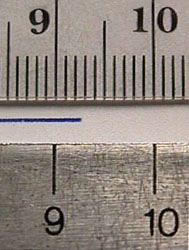
| 
| |
| We can be certain that the reading is between 26 and 27 ml. We should then estimate one more digit. In this case it is the tenths place. As the bottom of the meniscus appears to be seven tenths of the way from 26 to 27, our reported value should be 26.7 ml. | We can be certain that the reading is between 4.7 and 4.8 ml. We should then estimate one more digit. In this case it is the hundredths place. As the bottom of the meniscus appears to be three tenths of the way from 4.7 to 4.8, our reported value should be 4.73 ml. |
